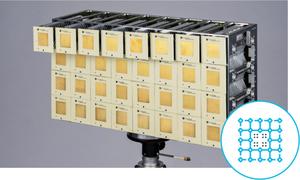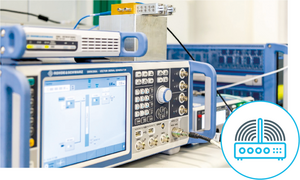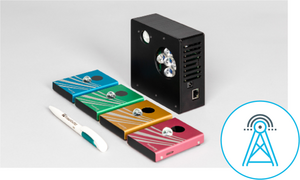5G will enable many new applications. In addition to mobile broadband, 5G will support extremely reliable low latency communications and a massive Internet of Things (IoT). To make this a reality, 5G combines a new air interface, backhaul and fronthaul transport network with advanced components designed specifically for 5G to enable future maximum data rates of more than 10 Gbps and latencies of less than 1ms. Researchers at Fraunhofer HHI are working on all these aspects, creating a center of excellence for 5G.
Competencies at Fraunhofer HHI

Air interface
- Channel measurements from below 6 GHz to above 100 GHz and suitability for 5G
- Light communication (LiFi) as a new wireless medium for special applications (industry etc.)
- Massive MIMO with beamforming for 5G
- Reciprocal Massive MIMO Antenna with 32 antenna Elements
- Infrastructure-free 5G networking solution for tactile communications and unserved Areas
- Various multi-connectivity technologies, e.g. the combination of cellular and satellite access in 5G
- V2X (vehicle to everything) links to increase safety and robustness in 5G Networks
- Wireless full duplex operation by compensation of the self-interference Signal

Backhaul-Networks and Components
- 28 GHz transceiver unit for 5G applications
- A robust combined optical/mm-wave link for the fronthaul of small radio cells
- A wireless THz-Link with a large transmission bandwidth for the backhaul of 5G base stations
- Scalable metro networks for 5G radio Access
- Utilization of optical fiber capacity by demand-oriented allocation of the bandwidth
- InP-based technology for various optical components up to 300 GHz
- Combination of III/V semiconductors with graphene for integration of e.g. laser and Modulator
- The energy efficiency of all components is a key issue in all 5G networks

Applications
- Private industry/enterprise networks for highly reliable and robust communications with guaranteed low latency (Industry 4.0, IoT)
- Flexible networking with low latency for Virtual Reality (VR) and Augmented Reality (AR) devices on-site e.g. for smart Buildings
- MPEG-OMAF standard for future VR services in 5G Networks
- Distributed computing and storage units (edge clouds) to serve 5G with low latency
- Optimal eavesdropping protection
- Artificial Intelligence (AI) and Machine Learning to optimize radio Access networks (RAN)
Standardization, implementation and optimization of 5G
- Participating in 3GPP: The 3rd Generation Partnership Project (3GPP) is the standardization organization for mobile technologies such as 5G
- 5G Berlin e.V.: Association of regional and international stakeholders to promote the start-up scene in and around Berlin. The networking of members and customers takes place within the 5G Center
- 5G test field: It contains all relevant technology components of a 5G network, e.g. for functional tests of innovative products
- ITU Focus Group on «Machine Learning for Future Networks including 5G»: creating specifications of AI for communications
- Anticipatory networking: employing AI to predict the quality-of-service before transmissions in 5G (yielding ultra-reliable and low-latency communications)
- Novel algorithms: combining data-driven and classical model-based AI approaches. Developing models that facilitate self-organizing networks, manage cognitive networks, and optimize energy conservation